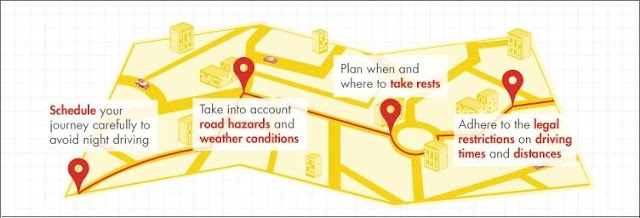Facefairfuture_For every journey one should ask if the journey is actually necessary; the safest journey is the one not taken. If the journey is necessary it is advised to consider other, safer, transportation options than car travel. This may include train or bus transport.
When making a road journey, whether it’s for business or pleasure, your chances of arriving safely are greatly increased by careful planning. Fail to plan adequately and your chances of being involved in an incident will increase.
A Journey Management Plan is typically a set process that you follow for planning and undertaking road transport journeys in compliance with HSSE requirements, with the goal of arriving safely. Every country and company will operate different standards but as a general rule, it is wise to put in place a Journey Management Plan for trips of more than 4.5 hours.
 |
| Fig. Journey Manajement Plan |
Top Tips
- Schedule your journey carefully to avoid night driving and those times of day when falling asleep is most likely (2am – 6am)
- Take into account road hazards and weather conditions
- Adhere to the legal restrictions on driving times and distances
- Plan when and where to take rests
- Allow for unexpected delays
- Take plenty of drinks with you so that you stay hydrated
- Know what to do in case of an emergency
Fatigue is one of the most obvious consequences
of poor journey planning and is a major contributing factor in road
traffic incidents. A good Journey Management Plan will take into account
all the factors that will minimise your chances of feeling sleepy
whilst driving. Check out our hints and tips on fatigue.
Simple steps to safety
Consider each element of your journey before you set off:- Define your route
- Make sure you can stay in communication
- Plan your rest periods and locations
- Think about the timing of your journey and how busy roads will be
- Identify black spots/route hazardous spots
- Consider the route options – different types of roads
- Check the road and weather conditions
- Identify high risk locations such as schools
- Personal welfare – keep hydrated with non-caffeine drinks
- Time your journey and allow extra time to account of unexpected delays
Take steps before you take to the road
Particularly if you are a professional driver, it is your responsibility to stay safe:- If your trip is more than 4.5 hours, you should have a Journey Management Plan
- Create a Journey Management Plan in conjunction with your Manager
- Check the roadworthiness of your vehicle, follow a simple Daily Vehicle Check
- Follow the route set out in your Journey Management Plan
- Always take breaks in the authorised rest areas
- If you have to divert from the route in any way, notify your Manager
- Have you got your mobile phone with you? Is it fully charged?
A Good Routine
A good Journey Management Plan is simple to put in place, and should quickly become part of your everyday routine. The more often you do it, the easier it will be to follow. We automatically follow many of the journey planning steps, without even thinking about it.Best Practice
By planning your journey more carefully, you are
more likely to stay fresh and vigilant at the wheel, safeguarding your
own safety and the safety of others.
Why limit a Journey
Management Plan to work journeys? On family and leisure trips, a few
simple steps could ensure that you and your family arrive alive.
Resource: Shell